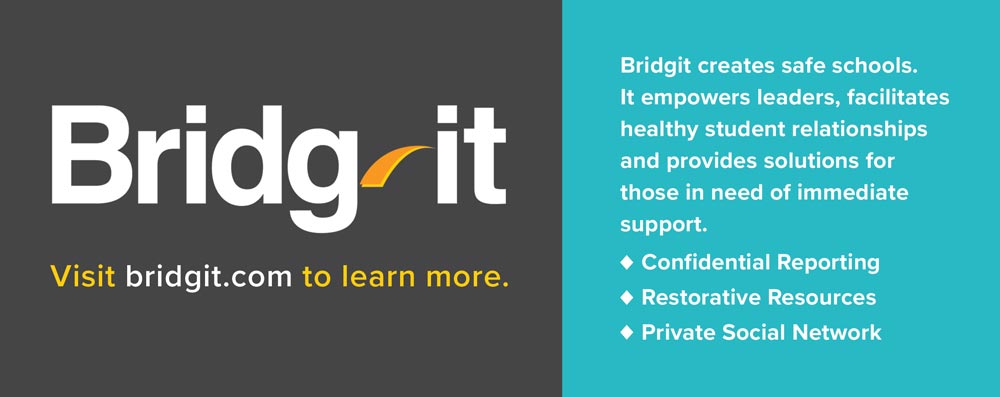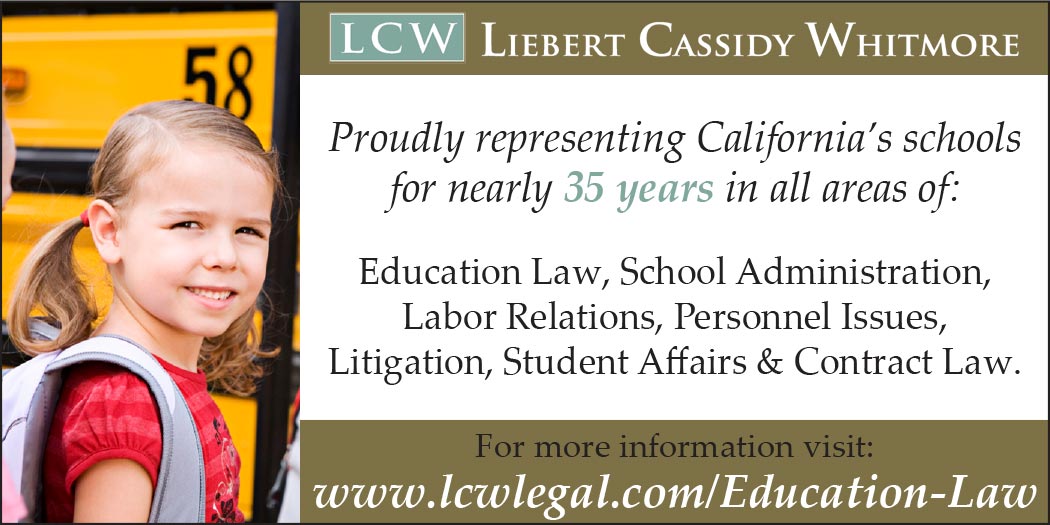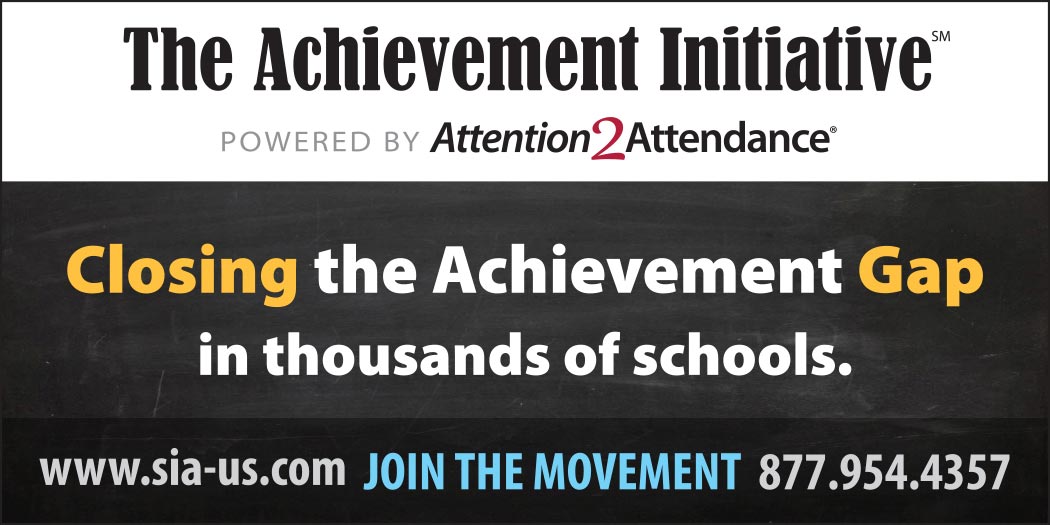

Highlighting new education laws in California
The new year will ring in a wide array of new education laws in California. To familiarize board members with 2018 legislation signed by Gov. Jerry Brown, CSBA has launched a weekly blog highlighting the laws and their impacts.
An overview of two new laws is provided below. Read the full blog posts at blog.csba.org.
The full What’s New for 2019 report on all new laws affecting K-12 education is also available at www.csba.org/whatsnewfor2019.
Assembly Bill 1248
Signed by the Governor on Sept. 27, Assembly Bill 1248 (Gloria, D-San Diego) clarifies that graduating students may wear traditional tribal regalia or recognized objects of religious or cultural significance as an adornment at school graduation ceremonies. CSBA opposed the bill until its language was amended to include protections for local control: “Nothing in this section shall be construed to limit a local educational agency’s discretion and authority to prohibit an item that is likely to cause a substantial disruption of, or material interference with, the ceremony,” the added language reads.
- Visit www.csba.org/Newsroom for links to digital versions of current and past issues of California School News.

legal
California bans for-profit charter schools after passage of AB 406
In September, Gov. Jerry Brown signed into law Assembly Bill 406, prohibiting for-profit charter schools in California.
The bill was supported by CSBA along with other organizations, including the California Charter Schools Association. Gov. Brown vetoed a similar bill in 2015, writing that he did not believe the case had been made to eliminate for-profit charter schools in the state. With the Governor’s signature secured, the new law will go into effect next year.

- The new law prohibits a charter school from being operated as, or operated by, a for-profit corporation.
- The bill also specifies that a charter school may not enter into a subcontract to avoid the requirements of the bill.
- The Governor’s signature secured, the new law will go into effect next year.
Current California law authorizes charter schools to operate as nonprofit corporations but is silent on whether a charter school is permitted to operate as a for-profit. Although for-profit charter schools have not been as common in California as in some other states, for-profit charter schools still serve tens of thousands of students in California. Legislative analysis on AB 406 found there are 34 charter schools in the state run by for-profit education management organizations or for-profit charter management organizations, serving more than 25,000 students. The track record of these for-profit charter schools in the state has been inadequate on several measures, including transparency and student achievement.

Troy Flint | tflint@csba.org
Managing Editor:
Kimberly Sellery | ksellery@csba.org
Marketing Director:
Serina Pruitt | spruitt@csba.org
Staff Writers and Contributors:
Hugh Biggar | hbiggar@csba.org
Aaron Davis | adavis@csba.org
Mike Ambrose | mambrose@csba.org
Andrew Cummins | acummins@csba.org
Graphic Design Manager:
Kerry Macklin | kmacklin@csba.org
Senior Graphic Designer:
Carmen Rodriguez | crodriguez@csba.org
Mike Walsh | Butte COE
President-elect:
Emma Turner | La Mesa-Spring Valley SD
Vice President:
Xilonin Cruz-Gonzalez | Azusa USD
Immediate Past President:
Susan Henry | Huntington Beach Union HSD
CEO & Executive Director:
Vernon M. Billy
News and feature items submitted for publication are edited for style and space as necessary.

leadership
President’s Message: Mike Walsh

Appreciation for the work done and the work left to do
In the February 2018 issue of this newsletter, I wrote about beginning the year with appreciation, appreciation for selecting me as your President, appreciation for the importance of the office and the responsibility that comes with it, and appreciation — in advance — for all the hard work you were about to do.
Now, as the year and my presidency draw to a close, I want to show appreciation once again. This time, I’m thankful for all the work you’ve done to move the organization forward in 2018. Nowhere has that advocacy been more evident than in the fight for Full and Fair Funding. By now, I’m sure everyone is aware that California has the fifth largest economy in the world and the highest GDP in the nation. While that’s a source of pride, it’s hard to celebrate when that same prosperity has yet to make it to public schools. We are still 41st nationally in per pupil funding, 45th in the percentage of taxable income spent on education, 45th in student-teacher ratios, and 48th in staff per student ratios. That is why so many of you passed resolutions calling on the Legislature to fund education at the national average by 2020, and the average of the top 10 states by 2025.
In that same article back in February, I reminded you that CSBA stands as a willing partner with local districts and county offices of education, and works as an ardent advocate on your behalf. That wasn’t just talk. There are so many ways in which CSBA led the fight for public education and local control in 2018. Allow me to highlight just a few.
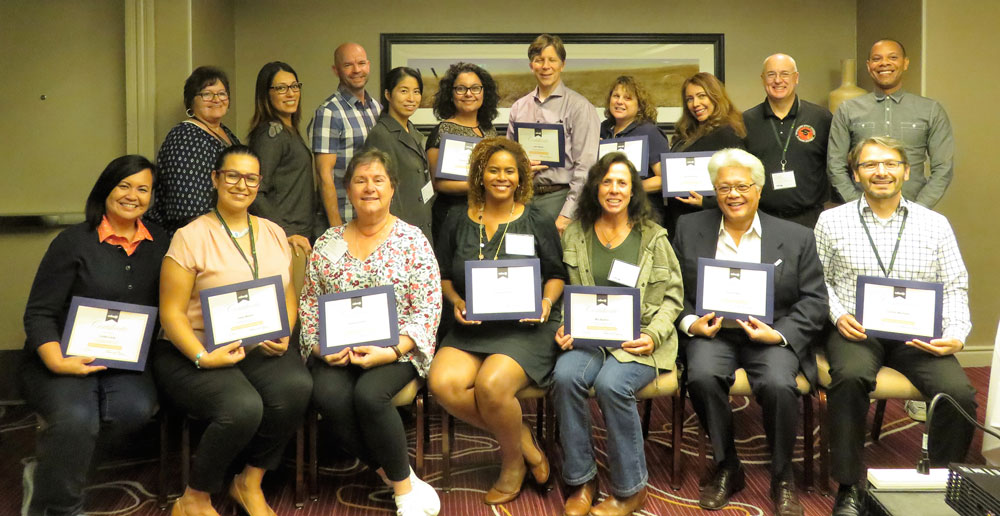
Teresa Guerrero, Board Member, Woodland Joint USD;
Tania Tafoya, Board Member, Woodland Joint USD;
Michael Pyeatt, Board President, Woodland Joint USD;
Kristen Lyn, Board Member, Cupertino Union SD;
Elizabeth Tienda, Board Member, Parlier USD;
Karen Bayne, Board Member, Woodland Joint USD;
Norma Alcala, Board President, Washington USD;
Tom Pritchard, Superintendent, Woodland Joint USD;
Troy Flint, CSBA
Front Row, L-R
Linda Luna, Superintendent, Washington USD;
Debbie Decker, Board Member, Woodland Joint USD;
Dionne Faulk, Board Member, Inglewood USD;
Mia Burton, Board Member, Pine Ridge ESD;
Darrel Woo, Regional Director, Region 6, Sacramento City USD;
Carlos Machado, CSBA
- What new information is important for LEA staff and school principals to know?
- What new information is important for families to know?
- How can Dashboard data be shared in a way that generates conversations and engages families around their child’s learning?
- What does the data tell us about our efforts to improve student achievement?
- What additional information is needed to help assess efforts to increase student achievement, i.e.: family surveys or listening circles?
- Do changes in data between years show an indication of growth, or are there indications of decline?
- Where there are indications of growth, are we able to identify the programs and supports that have contributed to improved student achievement?
- Where there are indications of decline, have we identified Local Control and Accountability Plan strategies that can address these areas?
- How can this information be helpful in our next review of the LCAP?
Board members can view the updated Dashboard as an additional tool to both engage families and to inform the board’s strategic decisions on supporting student achievement.
The use of data to support student achievement is covered in the CSBA report The School Board Role in Creating the Conditions for Student Achievement. More information is also available through the Student Learning and Achievement module of CSBA’s Masters in Governance, Course 2. Information on both resources can be found at www.csba.org.
Distinguished authors highlight AEC; state leaders to discuss California education
CSBA’s premier event — the Annual Education Conference and Trade Show — takes place at Moscone West in San Francisco from Nov. 29–Dec. 1.
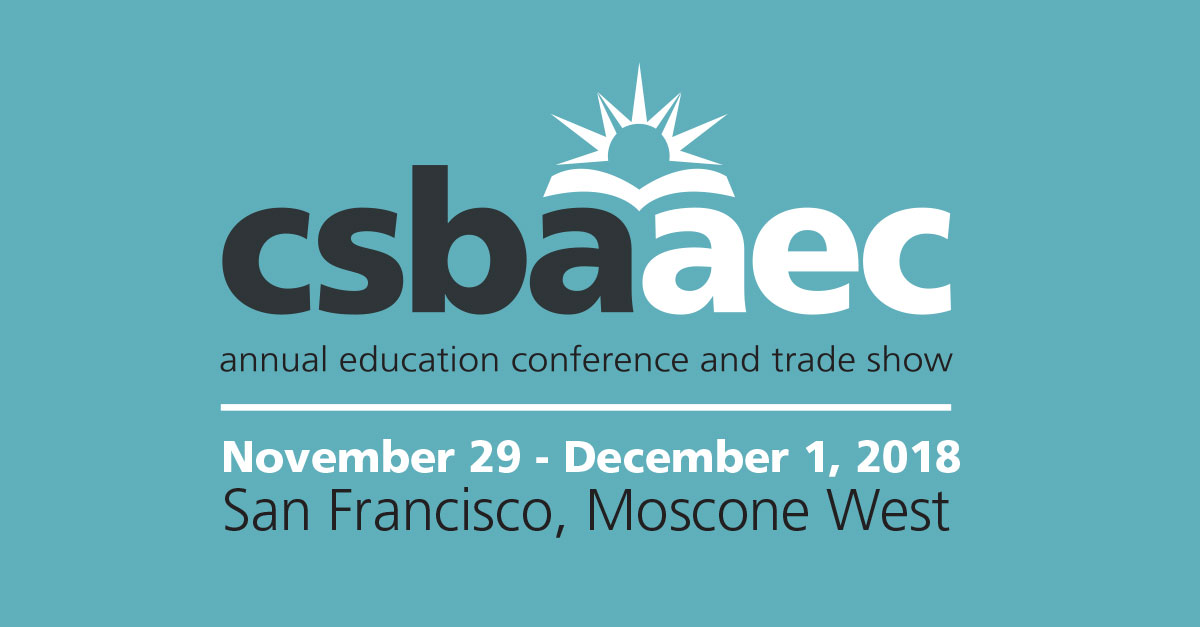
Drawing education leaders, trustees and school staff from across California, the conference provides critical issue and workshop sessions, table talks, networking and other activities to help governance teams from districts and county offices of education improve student learning and achievement, and advocate for public education. AEC also includes featured speakers for each of the conference’s General Sessions. A brief overview of this year’s speakers is below.
policy
New laws prompt need for board policy revisions
Gov. Jerry Brown signed more than 1,000 bills this year, about a tenth of which impact K-12 schools. Most of those will become effective Jan. 1, 2019.
“While boards should be reviewing and updating policies all year long, this is a particularly busy time of year for districts and county offices of education as they work to understand the implications of the new laws,” said Tezeta Stewartz, senior policy manual consultant for CSBA. “CSBA’s policy services can help governance teams to update their policies and consider best practices for effective implementation.”
Among the issues that districts will face in the coming months are:
- Local Control and Accountability Plan: State law requires districts, COEs and charter schools to address parent involvement among the state priorities in their LCAP, and now Assembly Bill 2878 (Chávez, R-Oceanside) broadens this priority to include family engagement. AB 1808, an education finance trailer bill, requires consultation with special education local plan area administrator(s) as part of LCAP review and development, and requires a Local Control Funding Formula budget overview for parents to be developed in conjunction with the LCAP. Policy impact: BP/AR 0460 – Local Control and Accountability Plan.
- School plans: AB 716 (O’Donnell, D-Long Beach) amends statutes related to school site councils and the single plan for student achievement to better align with the LCFF and the federal Every Student Succeeds Act. Certain small schools will be allowed to share a school site council. Policy impact: BP/AR 0420 – School Plans/Site Councils.
- Comprehensive school safety plan: Along with consultation with law enforcement in the development of a comprehensive school safety plan, AB 1747 (Rodriguez, D-Pomona) requires consultation with a fire department and other first responder entities. It also adds a requirement that the plan contain procedures for conducting tactical responses to criminal incidents, including procedures related to individuals with guns on school campuses and at school-related functions. Policy impact: AR 0450 Comprehensive Safety Plan.
resources
A focus on California’s Native American students
Native American Heritage Month, celebrated in November, is a time to recognize the significant contributions Native Americans made to the establishment and growth of the United States.
It also serves as a reminder to education leaders that Native American students in California face some of the most significant challenges of any student group. A new CSBA Governance Brief, “Native American Students in California Public Schools,” outlines how Native Americans are among the most socioeconomically disadvantaged K-12 students in the state and, based on several measures, the least connected to school.
Socioeconomic disadvantages and poor school connectedness
With a higher concentration of students in the smallest and most rural counties, 32,500 Native American students (identified as Native Alaskan and American Indian by the California Department of Education) are enrolled in California’s K-12 schools. Socio-economically, more than two in three (67.2 percent) of Native American students are disadvantaged, compared to fewer than one in three white students. Additionally, CSBA’s brief reports that nearly three in four (72 percent) Native American students attend high-poverty schools, where half or more of students are eligible for free or reduced-priced meals.
resources
Searching for a quality superintendent

Filling a superintendent vacancy is one of the most important job duties that school board members have on their plates. The superintendent is an integral part of the governance team and a good superintendent will be able to work in harmony with the board to help establish goals for the district and, most importantly, see those goals through to fruition.
The search for a superintendent requires ample dedication of both time and resources to define position criteria, advertise the open position, accept applications, and screen and interview candidates. Saugus Union School District Board President Chris Trunkey faced that challenge when the district’s superintendent announced her retirement to the board last winter. “As board members, I think all of us on our board have full-time jobs,” he explained. “It is hard to find the time that is necessary to be able to conduct a superintendent search, given all of the stakeholder input that was needed and the many meetings that we had that were related just to the search.”
resources
National Diabetes Month: Taking on type 2
While its biggest day features an oftentimes hefty meal, November is also National Diabetes Month — a time when education leaders can place an added focus on the health and well-being of students.
Type 2 diabetes has become increasingly common among children and adolescents as obesity rates rise, according to the California School-Based Health Alliance. Because the chronic condition is largely brought on by an unhealthy lifestyle, it is largely preventable through healthy eating and regular exercise. The American Diabetes Association advises that eating less fat, fried foods and sugar, in addition to exercising at least 30 minutes a day for five days a week, can delay and possibly prevent the onset of type 2 diabetes.
Schools can offer a setting where such practices are promoted and celebrated, said Melissa Cannon, policy advocate at California Food Policy Advocates in Oakland. A student’s home life might present barriers to a healthy lifestyle, with a parent working two jobs and not being able to cook dinner, for example, or a child living too far from a park to regularly exercise.
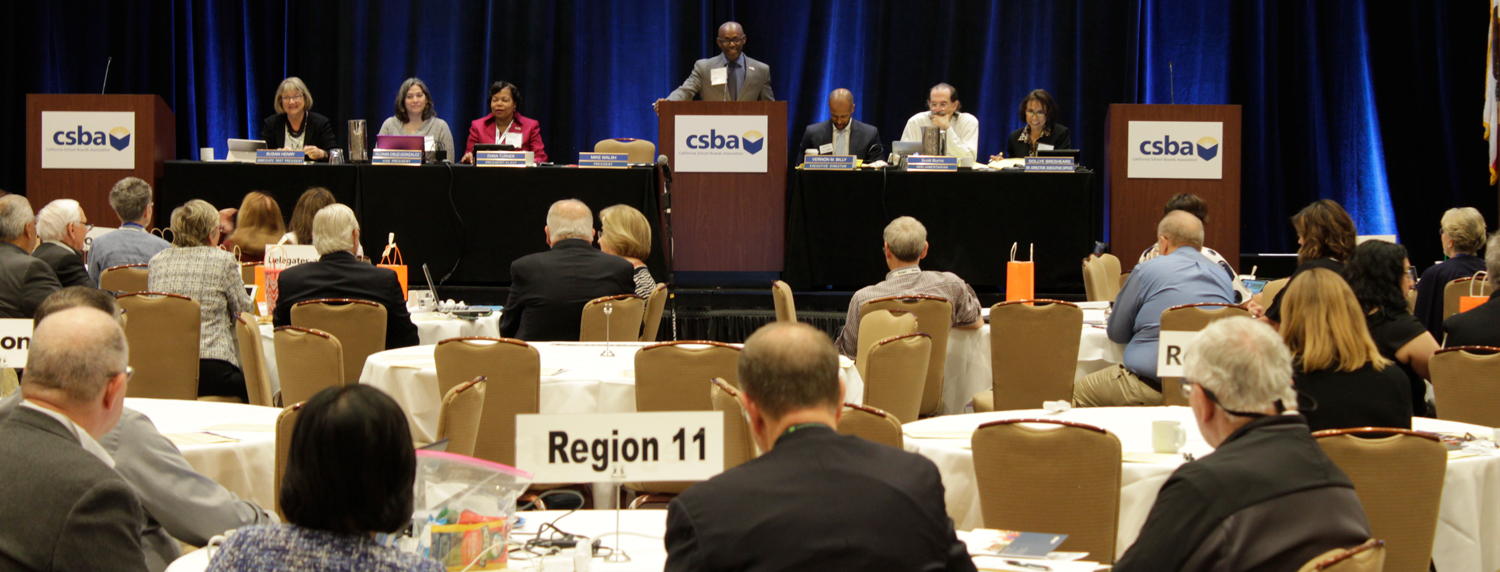
Any CSBA member board is eligible to nominate board members within its geographical region or subregion. Each board may nominate as many individuals as it chooses. The process begins with submission of the official nomination form, which is available on CSBA’s website.
All nominees must submit a candidate biographical sketch form along with their nomination form; an optional one-page, one-sided résumé may also be submitted, but a résumé cannot be substituted for the candidate biographical sketch form. All nomination materials must be postmarked by the post office no later than Monday, Jan. 7. It is the responsibility of the nominee to ensure that all nomination materials have been received by the CSBA Executive Office.
Nearly 200 county trustees from across California traveled to Monterey to take part and sharpen their leadership skills, network and gain insights on the latest education and legislative issues.
With the theme of “Empower Board Members — The How Tos,” the conference provided guidance on:
- Advocating for local control, and Full and Fair Funding of the state’s public schools
- Boosting achievement through leveraging the Local Control Funding Formula and Local Control and
- Accountability Plans
- Authorizing charter schools and the role of the county board
- Navigating the different roles and best practices between county boards and county superintendents
- Ensuring safety and secure campuses
Date of filing: October 12, 2018
Frequency of issue: Monthly
Number of issues published annually: 11
Annual subscription price: $4 (member)
$35 (non-member)
Location of known office of publication: 3251 Beacon Blvd., West Sacramento, CA 95691
Location of the headquarters of general business office of the publishers: 3251 Beacon Blvd., West Sacramento, CA 95691
Name and complete address of Senior Director of Communications and Marketing Director: Troy Flint and Serina Pruitt, 3251 Beacon Blvd., West Sacramento, CA 95691
Owner/Publisher: California School Boards As-sociation, 3251 Beacon Blvd., West Sacramento, CA 95691
Known bondholders, mortgages or other security holders owning or holding 1 percent or more of total amount of bonds, mortgagees or other securities: None
For completion of nonprofit organization authorized to mail at special rates: Have not changed during preceding 12 months
Total no. copies (net press run)
7,727
8000
7,242
7,415
46
48
0
0
0
0
0
0
0
0
0
0
0
0
7,288
7,463
439
537
7727
8000
100%
100%
Orientation for New Trustees
Board Presidents Workshop
Legal Symposium for Experienced Board Members
CSBA Annual Education Conference and Trade Show
2019 Institute for New and First-Term Board Members
MIG Courses 1 and 2
2019 Institute for New and First-Term Board Members

